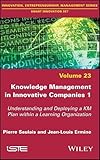Knowledge Management in Innovative Companies. 1 [electronic resource] : understanding and deploying a KM plan within a learning organization / Pierre Saulais, Jean-Louis Ermine.
Material type: TextSeries: Innovation, entrepreneurship, management series. Smart innovation set ; ; v. 23.Publication details: Newark : John Wiley & Sons, Incorporated, 2020.Description: 1 online resource (177 p.)ISBN:
TextSeries: Innovation, entrepreneurship, management series. Smart innovation set ; ; v. 23.Publication details: Newark : John Wiley & Sons, Incorporated, 2020.Description: 1 online resource (177 p.)ISBN: - 9781119681144
- 1119681146
- 9781119681175
- 1119681170
- 658.4/038 23
- HD30.2
Description based upon print version of record.
Cover; Half-Title Page; Title Page; Copyright Page; Contents; Preface; 1. The KM Project in an Organization; 1.1. Articulation of Chapter 1; 1.2. Knowledge management; 1.3. A reference framework for a knowledge-based KM; 1.3.1. Knowledge-based KM; 1.4. The virtuous cycle of knowledge; 1.4.1. Step 1: analysis of a knowledge capital and development of a KM plan; 1.4.2. Step 2: organization of knowledge resources; 1.4.3. Step 3: implementation of KM processes; 1.4.4. Step 4: evolution of a knowledge capital; 1.5. The MASK method; 1.5.1. MASK II: analysis of a knowledge capital
1.5.2. MASK I: capitalization of a knowledge corpus1.5.3. MASK III: sharing the knowledge base; 1.5.4. MASK IV: evolution of a knowledge capital; 1.6. The KM process repository; 1.7. Critical success factors for a global KM project; 1.7.1. The water lily strategy; 1.7.2. Key stages of change; 1.8. Overview; 2. Strategic Analysis of an Organization's Knowledge Capital; 2.1. Articulation of Chapter 2; 2.2. Introduction to the strategic analysis of knowledge capital; 2.2.1. Step 1: analysis of critical capacities; 2.2.2. Step 2: analysis of critical knowledge; 2.2.3. Step 3: strategic alignment
2.2.4. Step 4: developing the action plan2.2.5. The knowledge criticality analysis grid; 2.3. Chronopost: observing professions; 2.3.1. Presentation of the company; 2.3.2. Project context; 2.3.3. Objectives; 2.3.4. Approach adopted; 2.3.5. Procedure; 2.3.6. Strategic alignment; 2.3.7. Project assessment; 2.3.8. Lessons learned; 2.3.9. Conclusion; 2.4. Hydro-Québec; 2.4.1. Introduction; 2.4.2. Presentation of Hydro-Québec; 2.4.3. Presentation of the study conducted and the principles of the method used; 2.4.4. Implementation of the method at Hydro-Québec; 2.4.5. Conclusion
2.5. The IPEN's Radiopharmacy Center2.5.1. Presentation of the study; 2.5.2. The progress of the KM project; 2.6. Sonatrach; 2.6.1. Introduction; 2.6.2. Method used; 2.6.3. Strategic analysis; 2.6.4. Analysis of professional knowledge; 2.6.5. Conclusion; 2.7. Lessons learned from the four case studies; 3. Capitalizing on the Organization's Knowledge; 3.1. Articulation of Chapter 3; 3.2. Introduction to knowledge capitalization; 3.3. The case of INRS: a consulting approach to improve safety when using woodworking machines; 3.3.1. Introduction
3.3.2. Analysis of a reported incident or accident on a woodworking machine3.3.3. The dangers of woodworking machines; 3.3.4. Classification of woodworking machines; 3.3.5. History of INRS' involvement in the safety of woodworking machines; 3.3.6. Conclusion; 3.4. The case of code systems: knowledge books for code management and code control; 3.4.1. Introduction; 3.4.2. Reference framework for the development and use of codes; 3.4.3. Two new ways to manage knowledge on codes; 3.4.4. Example of an Euler buckling code; 3.4.5. Example of the description of an option in a code
3.4.6. Conclusion and perspectives
There are no comments on this title.
